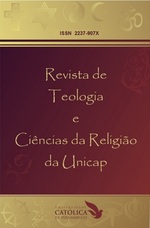"WRITE THEM ON THE DOORPOSTS OF YOUR HOUSE, AND ON YOUR GATES" (DEUT 6,9)
INTERPRETATION OF THE MEZUZAH THROUGHOUT HISTORY
DOI:
https://doi.org/10.25247/paralellus.2021.v12n31.p719-734Keywords:
Mezuzá;, Shemá; , Deuteronômio 6,4-9;, PortaAbstract
The article presents the transformations of the Hebrew word mezuzah, throughout history. In its original context, the term refers to the doorposts of the house, which may include the upper beam, or the two posts that flank the door. The biblical text commands that the words of God be written on the mezuzot, that is, on the doorposts of the house, in addition to having them written on the gates of cities (Deut 6.9). The order sounds, in the context, like a metaphor for listening attentively to the word, to internalize the divine command and to keep it always in sight (Deut 6.4-9). Following a common practice in the ancient Near East, this order was carried out literally, carving the words into the stone or wood of the doorposts. In the course of time, probably in the period of the Seleucid persecution, the words were written on parchments, rolled up in small tubular boxes and affixed to the doorjamb, similar to what happened with the tefillin. The word mezuzah came to designate, then, the cylinder that contains the scrolls of parchment with biblical writings and with the divine name Shadday. With this, the mezuzah became a religious symbol and object of devotion, with the addition of meanings that this reality represents.
Downloads
References
ALONSO SCHÖKEL, Luis. Dicionário bíblico hebraico-português. São Paulo: Paulus, 1997.
ANDIÑACH, Pablo R. O Livro do Êxodo: um comentário exegético-teológico. São Leopoldo: Sinodal; EST, 2010.
AUSUBEL, Nathan. Mezuzah. In: Conhecimento judaico. II. Rio de Janeiro: Koogan Editor, 1989. p. 558-559.
BibleWorks 10: Software for Biblical Exegesis and Research. Norfolk: Bibleworks, LLC, 2016.
Bíblia de Jerusalém. GORGULHO, Gilberto da Silva; STORNIOLO, Ivo; ANDERSON, Ana Flora Anderson (Coords.). São Paulo: Paulus, 2012.
Bíblia do Peregrino. ALONSO SCHÖKEL, Luís (Ed.). São Paulo: Paulus, 2002.
Biblia Hebraica Stuttgartensia (BHS). KITTEL, Rudolf (Ed.). Editio quarta emendata opera H. P. Rüger. Stuttgart: Deutsche Bibelgesellschaft, 1967.
Bíblia Sagrada Almeida. Tradução de João Ferreira de Almeida. Revista e atualizada. São Paulo: Sociedade Bíblica do Brasil, 1993.
Bíblia Sagrada CNBB. KONINGS, Johan (Coord.). Brasília: CNBB, 2006.
Bíblia Sagrada Vozes. GARMUS, Ludovico (Coord.). Petrópolis: Vozes, 2001.
Bíblia Tradução Ecumênica (TEB). KONINGS, Johan (Supervisão). São Paulo: Loyola, 1994.
BUDALLÉS DIEZ, Mercedes de. A ternura e exigência do Shemá. Estudos Bíblicos, Petrópolis, v. 63, p. 58-62, 1999.
BUIS, Pierre. Le Deutéronome. Paris: Beauchesne, 1969.
CEOLIN, Nelvi Jorge. Ouvir e amar a Javé: Dt 6,4-9: um caminho para a cultura de paz. Dissertação de Mestrado. Porto Alegre: PUC RS, 2006. Disponível em: Ouvir e amar a Javé: Dt 6, 4-9: um caminho para a cultura de paz Consulta em: 08/01/2022.
DERBY, Josiah. ‘… Upon the Doorposts…’. Jewish Bible Quarterly, v. 27, n. 1, p. 40-44, Jan-Mar 1999.
DOUGLAS, J. D. (Org.). O Novo Dicionário da Bíblia. São Paulo: Vida Nova, 2006.
FÁBRIS, Rogério de. Antropologia semítica: uma análise exegética da perícope de Dt. 6,1-9, com aproximação do vocábulo lev. Dissertação (Mestrado em Ciências da Religião). São Bernardo do Campo: UMESP, 2014. Disponível em: http://tede.metodista.br/jspui/handle/tede/296 Consulta em: 17/01/2022.
FERREIRA, Aurélio Buarque de Holanda. Novo Dicionário da Língua Portuguesa. Rio de Janeiro: Melhoramentos, 1975.
FRANCISCO, Edson de Faria. Manuscritos do deserto da Judeia: introdução geral. Estudos Bíblicos, Petrópolis, v. 34, n. 136, p. 361-381, out/dez 2017. Disponível em: https://revista.abib.org.br/EB/article/view/84/86 Consulta em: 15/01/2022.
FRIZZO, Antônio Carlos. O Shemá Israel, em Dt 6,4-9: o mandamento de Deus contra a idolatria. Revista de Cultura Teológica, São Paulo, v. 9, n. 34, p. 99-108, 2001.
GORDON, Martin L. Mezuzah: Protective Amulet or Religious Symbol? Tradition, v. 16, n. 4, p. 7-40, Sum 1977.
JANSSON, Eva-Maria. The Magic of the Mezuzah in Rabbinic Literature. Nordisk Judaistik, v. 15, n. 1-2, p. 51-66, 1994.
KAEFER, José Ademar. Arqueologia das terras da Bíblia II. São Paulo: Paulus, 2016.
KIRST, Nelson et al. Dicionário Hebraico-Português & Aramaico-Português. São Leopoldo; Petrópolis: Sinodal; Vozes, 1989.
LANDSBERGER, Franz. The Origin of the Decorated Mezuzah. Hebrew Union College Annual, v. 31, p. 149-166, 1960.
LEMAIRE, André. Deuteronomy 6:6,9 in the Light of Northwest Semitic Inscriptions. In: COHEN, Chaim et al. (Eds.). Birkat Shalom: Studies in the Bible, Ancient Near Eastern Literature, and Postbiblical Judaism Presented to Shalom M. Paul on the Occasion of His Seventieth Birthday. University Park: Penn State University Press, 2021. p. 525-530.
LURIA, Ben Zion. The Development of the Mezuzah. Dor le Dor, v. 5, n. 1, p. 6-15, 1976.
MCKENZIE, John L. Dicionário bíblico. São Paulo: Paulinas, 1983.
MILGROM, J. mezûzâ. In: BOTTERWECK, G. Johannes; RINGGREN, Helmer (Orgs.). Theological Dictionary of the Old Testament. v. VIII. Cambridge: Eerdmans, 2003. p. 225-227.
OTTO, E. ša‘ar. In: BOTTERWECK, G. Johannes; RINGGREN, Helmer (Orgs.). Theological Dictionary of the Old Testament. v. XV. Cambridge: Eerdmans, 2003. p. 359-405.
PERONDI, Ildo. Estas palavras e o Shemá. Pistis & Praxis, v. 11, n. 2, p. 311-326, 2019. https://www.researchgate.net/publication/335585317_Estas_palavras_e_o_Shema Consulta em: 09/01/2022.
PINTO, L. P. da S. O Shemá e a devoção a uma só divindade. Horizonte, v. 17, n. 52, p. 20-42, abr 2019. Disponível em: http://periodicos.pucminas.br/index.php/horizonte/article/view/P.2175-5841.2019v17n52p20/14770 Consulta em: 14/01/2022.
REED, Stephen. Physical Features of Excerpted Torah Texts. In: EVANS, Craig A.; ZACHARIAS, H. Daniel (Eds.). Jewish and Christian Scripture as Artifact and Canon. London: T & T Clark, 2009. p. 82-104.
SCHIFFMAN, Lawrence H. Phylacteries and Mezuzot. In: SCHIFFMAN, Lawrence H.; VANDERKAM, James C. (Eds.). Encyclopedia of the Dead Sea Scrolls. Vol. 2. Oxford: Oxford University Press, 2000. p. 675-677.
SILVA, Ruben Marcelino Bento da. Assombrações na Bíblia Judaica: estudo classificatório sobre tradições folclóricas de demônios e fantasmas difundidas no Antigo Israel e subjacentes aos textos hebraicos canônicos. Dissertação: Mestrado em Teologia. São Leopoldo: EST, 2012a. Disponível em: http://dspace.est.edu.br:8080/xmlui/handle/BR-SlFE/284 Consulta em: 06/01/2022.
SILVA, Valmor da. Meu filho, minha instrução não esqueças – Leitura de Pr 3,1-12. In: GASDA, Élio Estanislau (org.). Sobre a Palavra de Deus: Hermenêutica bíblica e Teologia Fundamental. Petrópolis; Goiânia: Vozes; PUC Goiás, 2012b. p. 89-102.
SOUZA, Renan Daniel de. O ensino da Bíblia e a educação cristã: reflexão teológica em Deuteronômio 6:4-9. Hermenêutica, v. 13, n. 2, p. 11-24, 2013. Disponível em: https://seer-adventista.com.br/ojs3/index.php/hermeneutica/article/view/418 Consulta em: 15/01/2022.
TIGAY, Jeffrey H. Deuteronomy. Philadelphia; Jerusalem: The Jewish Publication Society, 1996. (The JPS Torah Commentary).
VAN DEN BORN, A. (Org.). Dicionário Enciclopédico da Bíblia. Petrópolis: Vozes, 1971. col. 576 (filactérias); col. 987-988 (mezuza).
VON RAD, Gerhard. Deuteronomio. Traduzione italiana di Antonio Dal Bianco. Brescia: Paideia, 1981.
YISRAELI, Oded. The Mezuzah as an Amulet: Directions and Trends in the Zohar. Jewish Studies Quarterly, v. 22, n. 2, p. 137-161, Jun 2015.
Downloads
Published
Versions
- 2021-12-29 (2)
- 2021-12-29 (1)
Issue
Section
License
Copyright (c) 2021 Valmor da Silva, Rosemary Francisca Neves Silva, Maria Ciurinha Pereira dos Santos

This work is licensed under a Creative Commons Attribution 4.0 International License.
A submissão de originais para a Paralellus implica a transferência, pelos autores, dos direitos de publicação eletrônica. Os direitos autorais para os artigos veiculados neste periódico são do autor; todavia, são da revista os direitos sobre a primeira publicação. Os autores somente poderão fazer uso dos mesmos resultados em outras publicações se indicarem, claramente, que a Paralellus foi o meio originalmente utilizado. Em decorrência do fato de ser a Paralellus uma revista de acesso público, é permitida a utilização gratuita dos artigos em aplicações educacionais e/ou científicas não comerciais, desde que respeitando-se a exigência de citação da fonte (Texto atualizado em 16-11-2020).

















